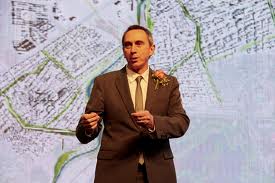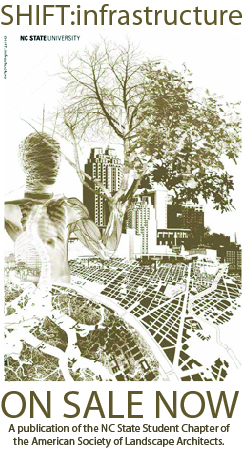The NCSU LAR Lecture Series Presents Charles Waldheim
In a public lecture on February 25, 2013 as part of the NCSU Landscape Architecture Lecture Series—architect-come-landscape architect and chair of the landscape architecture department at The Harvard University Graduate School of Design (referred to throughout the lecture as “The GSD” [with a capitol “T”])—Professor Charles Waldheim spoke on the expanding role and importance of landscape architecture in city planning and building. Waldheim’s work and research in this area—branded “landscape urbanism” in contemporary academic architectural parlance—synthesizes diverse theories, ideologies and practices regarding the role of landscape in city-building (as opposed to buildings-first models of urban planning, growth and development).
Waldheim suggested that landscape architecture, as a discrete vocation in the mid-19th century, was manifest as a fulcrum of city planning and design (think Frederick Law Olmsted), but as urban planning gradually was hewn from the profession, “the urban part got away.” According to Waldheim, successful city design strategies now must rejuvenate ecologies’ ability to support density and urbanity by hybridizing new systems with existing hard and soft systems (paradoxically, a seeming reversal of the McHarg model?). In order to address these issues effectively, Waldheim proposed a return to historic precedents for landscape as a primary organizational medium for city planning, building, and development. He asserted that landscape architects are the obvious choice for the job, as they are not only highly skilled design professionals capable of providing effective solutions to complex, nonlinear problems, but also experienced environmental advocates who are specially equipped with ecological and environmental awareness, which is increasingly relevant to market needs. In fact, according to Waldheim, landscape architects increasingly are primary drivers in city-building, and building architects are “looking over their shoulders” as buildings-first models of city planning and design become less culturally and ecologically relevant. Waldheim proposed that landscape architects should, in fact, be the true “urbanists of our age,” as they are equipped with a unique and highly valuable “tool-kit” combining professional design capabilities with the experience and awareness of environmental stewardship and advocation.
Professor Waldheim continued with thoughts on educating landscape architects and presented a slide show of current technological and pedagogical experimentation at The Harvard University Graduate School of Design. He noted increasing trends in cross-discipline specialities in new landscape architects (particularly regarding the arts and building architecture), as well as increased interest in, and need for, brown-field planning. Waldheim concluded with playful speculation on the rapidly evolving tools and technologies of the profession, forecasting a near future where static imagery well may be regarded as “kind of quaint.”
–Paul D. Sayre
Further reading:
Environment@Harvard Volume 3, Issue 1
http://www.gsd.harvard.edu/#/people/charles-waldheim.html



